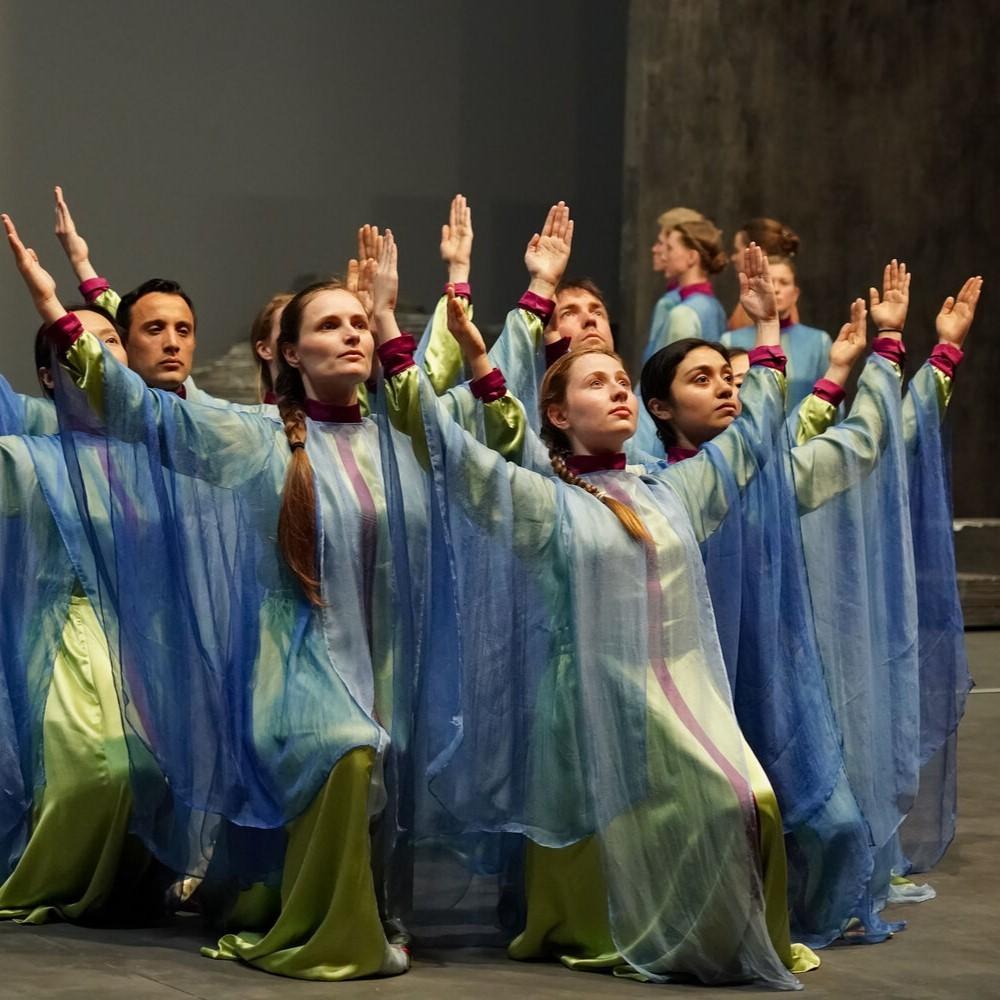A synthesis of the arts!
Media response to Jasmin Solfaghari’s Parsifal production at the Goetheanum. Compiled by Wolfgang Held.
‘Taking the consecration seriously’
Björn Florian Fuchs of the German radio station Deutschlandfunk finds no interpretation and no message in the production but rather that it ‘takes the consecration, the work’s sacred atmosphere, seriously’. The ‘outsourcing’ of props one could ‘take in as an aesthetic pleasure’ according to Fuchs. The Baden-Baden Philharmonic ‘did extremely well’ under Roland Fister. The same was true for the choirs. A synthesis of the arts had been achieved, ‘essentially inspired, animated and energized by the director, Jasmin Solfaghari’. The ensemble was good, Fuchs pointed out, with some loss of energy though in Act 3. ‘If one settles down for a five-hour evening programme, one takes in a lot and it is horizon-broadening not only for Wagnerians because, beyond anything religious and metaphysical, Rudolf Steiner’s eurythmy and theatre aesthetics are also a cultural phenomenon and we experience a piece of cultural history.’ (Deutschlandfunk, 3 April 2023)

Eurythmy creates ‘bridges of meaning’
‘Jasmin Solfaghari’s production, Stefan Hasler’s eurythmy and Walter Schütze’s design conveyed a surprisingly well-rounded impression and some thought-provoking impulses. Ivonne Fuchs as a sensational Kundry and Alejandro Marco-Buhrmester as Anfortas stood out from the cast,’ writes Roland Dippel in Neue Musikzeitung. He describes how the eurythmy ensemble and the professional opera singers inspired each other. ‘This kind of artistic lighting concept, inspired by Adolphe Appia, with block and step elements has probably not been seen before on the Goetheanum stage. Conversely, the ideals of anthroposophy are in opposition to the central Parsifal problems.’ The eurythmy generated ‘bridges of meaning’ and ‘strong theatrical effects.’ Dippel calls Ivonne Fuchs as Kundry ‘the discovery of the night among the singers.’ Walter Schütze’s costumes he experiences as a playing between picture-book Middle Ages and twentieth century reform movement. The orchestra and choir he credits with a ‘broad and open overall sound,’ Alejandro Marco-Buhrmester as Anfortas is very impressive and Andreas Hörl’s Gurnemanz has ‘strong cantability.’ Dippel concludes that the production was an ‘essential impulse for a discourse on the relevance of (music) theatre and the target groups of the future.’ (Neue Musikzeitung, 8 April 2023)

‘Exploring and enlivening the soul life’
Bernhard Doppler (of the radio station MDR-Klassik) wonders, as do many others, why Wagner’s Parsifal is only performed at the Goetheanum now, a hundred years after its completion. The eurythmy, he concedes, allows for ‘dramatic confrontations and solemn narratives which unfold a definite theatrical dynamic compared to dance.’ Doppler misses in this production a ‘critical-intellectual – maybe even ironic – interpretation of Wagner’s thought construct,’ but praises the musical performance: ‘What is most impressive in Dornach is the professional musical achievement. The orchestra is possibly too big, and maybe Wagner’s music is too violent for the Waldorf spirit, but on the other hand it keeps flooding the audience, coming from behind, too – as a communal experience. Roland Fister conducts the Philharmonic Orchestra effectively, the singers master their challenging parts effortlessly, showing us their wounds and allowing us to suffer with them.’ Doppler sees the production as the attempt ‘to explore and enliven the soul life’ and therefore as an alternative to traditional opera. (MDR-Klassik, 4 April 2023)

‘A not uninteresting contribution’
Fabian Kristmann, of the Basler Zeitung, describes Jasmin Solfaghari’s style as a stringent directing of individuals but would have wished for more dramatic expression: ‘The seduction scene between Kundry and Parsifal was almost concertante.’ ‘Kundry sometimes seemed to tell a story.’ However, he praises the textual comprehensibility and intonation and Gurnemanz’s ‘full and robust timbre’. Roland Fister’s ‘rich Wagner sound’ sometimes lacked differentiation. Kristmann experienced the eurythmy as an ‘emotional and thematic aura’ that sometimes seemed like a duplication. He also pointed out, however, that presenting the grail, spear and swan in eurythmy lent the production ‘additional, immediately tangible substance.’ The Goetheanum, Kristmann concludes, had made ‘a not uninteresting contribution’ with this production. (BAZ, 3 April 2023)

‘Naturalistic, clear and close to the text’
‘If the stage consecration festival has ever seemed right outside the Bayreuth opera temple, then it has here,’ Christian Wildhagen writes in his review in the Zurich newspaper NNZ (Neue Zürcher Zeitung) with a view to the Goetheanum’s exclusive position. He sees no Anthroposophy in the production: ‘Those who had expected this production to monopolize or re-interpret Parsifal were wrong.’ Representing the props through eurythmy was a clever move according to Wildhagen, who saw this as a reference to Rudolf Steiner’s postulate of an immaterial world. Jasmin Solfaghari’s production style he describes as ‘naturalistic, clear and close to the text.’ The orchestra surpassed itself under Roland Fister’s baton and sounded similarly suggestive as in Bayreuth, although even there one would rarely hear ‘such a gripping encounter between Parsifal and Kundry.’ (NZZ, 6 April 2023)

Advance booking for the performances at Easter 2024 from 1 July 2023
More information parsifal-wagner.ch
Images Rehearsal photo, Wagner’s Parsifal at the Goetheanum
Main picture Ariane Totzke

